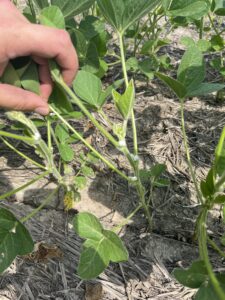Illinois Crop Update – July 11, 2025
Steve Brand– Commercial Agriculture Specialist
Grundy and DeKalb Counties
Soil Conditions: Mildly Dry (soil is drier than normal, plant growth may have slowed)
Another dry week for northern IL with a few isolated storms occurring further west or in Chicago. We have slid back into a predominantly D1 drought, with large areas of Kane and Will County entering into a D2 drought. Corn and soybeans have started to grow out of the early season stunting, but both crops are looking likely to be short overall this season. Temperatures dropped a little bit this past week but were still in the mid to upper 80s. Depending on planting date corn is between 1200-1250 growth degree units as we continue to progress through the season.
Corn is averaging V11-V13 across the region. Some isolated fields are still lagging quite a bit behind around V8-V9, but an overwhelming majority are spiking. Ears are starting to develop, and a small handful of fields have tassels emerging. I expect by next week most fields will have tasseling corn. Disease is still incredibly low for this time of year. I have not found tar spot in any fields that I have scouted, let alone gray or northern blight. Many areas south of the I-80 corridor have confirmed cases, with the only county in the north being Carroll County out west. I continue to encourage scouting of your fields regularly to stay on top of the diseases. I have not seen any insect pests, but fall armyworm damage has been reported in sweet corn so that is something to monitor.
Soybeans are beginning to enter R3 as pods are developing on the lowest nodes. Plants are healthy and beginning to fully shade out the rows. I have not seen any diseases yet due mostly to the weather. Japanese beetles are present in most fields, but numbers aren’t anything to be concerned about currently. I have seen quite a bit of herbicide residual burn on beans this season, and it’s unclear if the hot and dry weather is the culprit or different chemical mixes. Either way the beans are growing out of it.
If you see any disease, insect damage or anything else of note as the season continues, please feel free to email me images with descriptions to sbbrand2@illinois.edu
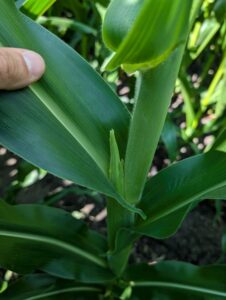
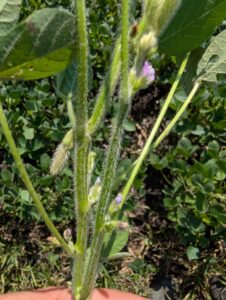
Russ Higgins – Commercial Agriculture Educator
Grundy County
Soil Conditions: Moderately Dry (soil is dry, plants may be browning or stressed, water bodies are low)
More hit and miss rainfall last week in NE Illinois as additional corn acres begin to reach VT (tassel). Areas that received rainfall are faring considerably better than those that did not. Corn growing in fields with gravelly knolls and lighter or sand soils that did not receive recent rains are showing significant stress. Fungicide applications have started in the area, in scouting visits to R1 corn fields the only disease noted was sporadic Northern corn leaf blight. This disease is recognizable by the cigar or canoe-shaped lesions formed on leaf tissue. The causal pathogen for this fungal disease overwinters on corn leaf debris. Hybrid resistance normally is adequate for management of the disease, but substantial losses can take place with early infection and susceptible hybrids. Interesting, but normally not economically important, leaf feeding was also noted in the corn. The corn blotch leaf miner is a small fly that deposits eggs on either the upper or lower corn leaf surface. After hatching the larva tunnels in the leaf feeding on the inner leaf tissue as it grows, leaving behind mines or transparent galleries. Eventually the larva will chew its way out of the leaf and drop to the soil and pupate. I’m finding very limited leaf feeding despite the presence of Japanese beetles and no diseases at this point in the growing season in soy fields visited.
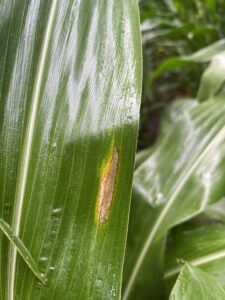
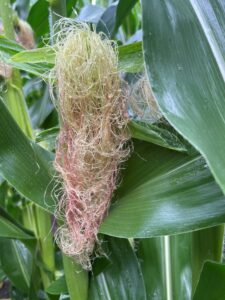
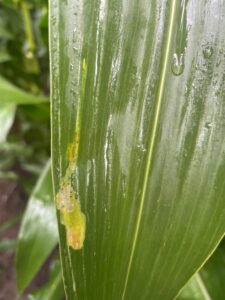
Reagan Tibbs – Commercial Agriculture Educator
Logan County
Soil Conditions: Moderately Dry (soil is dry, plants may be browning or stressed, water bodies are low)
The growing season is entering a key phase, during which many fields and plants are transitioning into the reproductive stage of growth. Nearly all of the corn fields in the area have entered the R1 phase, with some likely further along. There are some fields still in the later V-stages, but they won’t be behind the rest for too long. Much of the same story can be said with soybeans, with some more mature fields in the R1-R2 phase, while some less mature fields in the later V-stages. Rainfall has also been variable across the area over the last week. Some parts of the county received around an inch of rain, while some received a half inch or less.
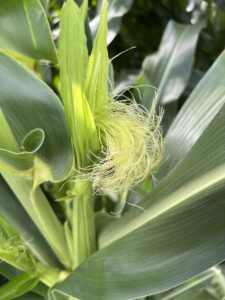

Doug Gucker – Local Food Systems and Small Farms Educator
Dewitt, Macon, and Piatt County
Soil Conditions: Mildly Dry (soil is drier than normal, plant growth may have slowed)
Currently, the corn and soybean crops are looking good. Some corn in the drier areas has fired on the lower leaves.
Soybeans vary from V5 to R3 (beginning pod). Corn varies from V10 to R2 (blister), with most of the corn crop in the R1 stage. Weed control is generally looking good. However, the amaranths are beginning to poke above the soybean canopy in some soybean fields.
The past 14-day rainfall has been over 150% of normal in southern Macon and Piatt Counties to less than 25% of normal through the balance of the 3-county area.
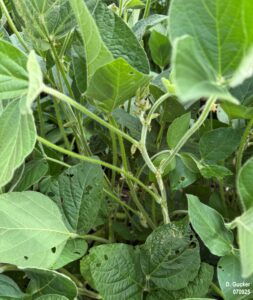

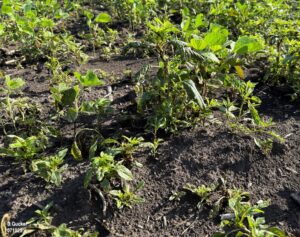
Nick Seiter – Extension Field Crops Entomologist
Champaign County
Now is the time to begin monitoring corn rootworm beetles, both to evaluate performance of traits/insecticides used this year, and to gauge the need for control next year. We will again be distributing yellow sticky traps to anyone interested in participating in our regional corn rootworm adult monitoring network in 2025. Learn more about the network and view reports from previous years. If you are interested in participating and would like for me to send you traps and/or the sampling protocol, please send me an email (nseiter@illinois.edu) with the following information:
- Your name and shipping address
- The number of corn and soybean fields you plan to monitor
Talon Becker – Commercial Agriculture Specialist
Douglas County
Soil Conditions: Near Normal
With about 0.5-1.0″ of rain and some cooler temperatures this past week, corn and soybean crops in Douglas County are looking healthy during this vital flowering period. Most soybean fields are somewhere between the full flowering (R2) and beginning pod (R3) stages, with a few fields moving into full pod (R4). At least 50% of the corn fields I saw during my survey had started to flower. Most of those fields were still in the early stages of silking and anthesis (R1), but a couple fields I visited were entering the blister stage (R2).
Wheat fields I drove by had all been harvested. Many had been planted to double crop soybeans sometime last week before the rain, and I saw a couple farmers out getting ready to roll again as soils dried enough to allow for field traffic. In the southwest part of the county, several alfalfa fields had their second cutting, with one or two still standing. Oat fields looked to be a week or so away from harvest.
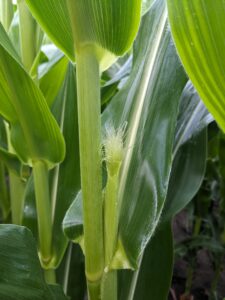
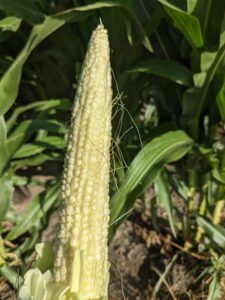
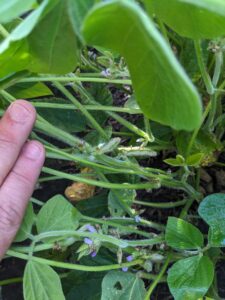
Dane Hunter – Commercial Agricultural Specialist
Marion County
Soil Conditions: Near Normal
In Franklin County this week, I found a couple of soybean fields in full flowering, R2, despite being shin-knee high. Beans in this area vaulted straight into flowering at only V5-V6 since days have started shortening after the solstice. Most double-crop beans are in the ground and at VE-VC.
On the corn side I have seen one field tasseling; it must have been an atypical field that got planted in April. Most corn fields are still vegetative, V9-V10 with no sign of tassels yet.
